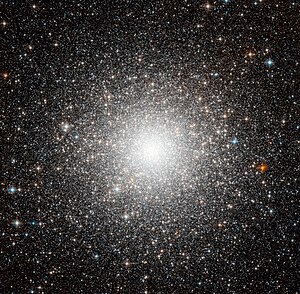Messier 54
| Kugelsternhaufen Messier 54 | |
|---|---|
 | |
| Aufnahme des Zentrums von Messier 54 mithilfe des Hubble-Weltraumteleskops | |
| AladinLite | |
| Sternbild | Schütze |
| Position Äquinoktium: J2000.0, Epoche: J2000.0 | |
| Rektaszension | 18h 55m 03,28s [1] |
| Deklination | −30° 28′ 43″ [1] |
| Erscheinungsbild | |
| Konzentrationsklasse | III [2] |
| Helligkeit (visuell) | 8,37 mag [1] |
| Helligkeit (B-Band) | 9,20 mag [1] |
| Winkelausdehnung | 9,1' [1] |
| Physikalische Daten | |
| Integrierter Spektraltyp | F7/F8 |
| Rotverschiebung | 0,000473 ± 0,000002 [1] |
| Radialgeschwindigkeit | (141,9 ± 0,5) km/s [1] |
| Entfernung | 87,4 kLj (26,8 kpc) [3] |
| Durchmesser | 300 Lj [3] |
| Geschichte | |
| Entdeckung | Charles Messier |
| Entdeckungsdatum | 24. Juli 1778[4] |
| Katalogbezeichnungen | |
| M 54 • NGC 6715 • C 1851-305 • GCl 104 • | |
Messier 54 (auch als NGC 6715 bezeichnet) ist ein 8,4 mag heller Kugelsternhaufen mit einer Flächenausdehnung von 9,1' im Sternbild Schütze, südlich des Sterns Sigma Sagittarii. M 54 ist in Mitteleuropa wegen seiner südlichen Position nicht leicht zu beobachten.
Der Kugelsternhaufen hat besondere Beachtung gewonnen, seit bekannt ist, dass er nicht zum Kugelsternhaufensystem der Milchstraße gehört, sondern mit der Sagittarius-Zwerggalaxie assoziiert ist. Da diese Galaxie, die nach der Canis-Major-Zwerggalaxie der nächste Nachbar unserer Milchstraße ist, erst 1993 entdeckt wurde, galt Messier 54 bis dahin als Kugelsternhaufen der Milchstraße. Zusammen mit Messier 79, der mit der Canis-Major-Zwerggalaxie assoziiert ist, ist er daher der am längsten bekannte außergalaktische Kugelsternhaufen.
Weblinks
Einzelnachweise
- ↑ a b c d e SIMBAD-Abfrage
- ↑ NED data for the Messier Objects
- ↑ a b Messier 54 bei SEDS
- ↑ https://cseligman.com/text/atlas/ngc67.htm#6715
Auf dieser Seite verwendete Medien
Bildtafel der 110 Messier-Objekte. Diese Datei wird in der w:de:Template:Navigationsleiste Messierobjekte als Imagemap genutzt. Sie darf daher nicht durch eine andere Version überschrieben werden!
Autor/Urheber: ESA/Hubble & NASA, Lizenz: CC BY 3.0
The object shown in this beautiful Hubble image, dubbed Messier 54, could be just another globular cluster, but this dense and faint group of stars was in fact the first globular cluster found that is outside our galaxy. Discovered by the famous astronomer Charles Messier in 1778, Messier 54 belongs to a satellite of the Milky Way called the Sagittarius Dwarf Elliptical Galaxy.
Messier had no idea of the significance of his discovery at the time, and it wasn’t until over two centuries later, in 1994, that astronomers found Messier 54 to be part of the miniature galaxy and not our own. Current estimates indicate that the Sagittarius dwarf, and hence the cluster, is situated almost 90 000 light-years away — more than three times as far from the centre of our galaxy than the Solar System.
Ironically, even though this globular cluster is now understood to lie outside the Milky Way, it will actually become part of it in the future. The strong gravitational pull of our galaxy is slowly engulfing the Sagittarius dwarf, which will eventually merge with the Milky Way creating one much larger galaxy.
This picture is a composite created by combining images taken with the Wide Field Channel of Hubble’s Advanced Camera for Surveys. Light that passed through a yellow-orange (F606W) was coloured blue and light passing through a near-infrared filter (F814W) was coloured red. The total exposure times were 3460 s and 3560 s, respectively and the field of view is approximately 3.4 by 3.4 arcminutes.


